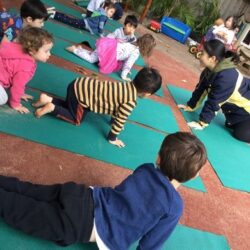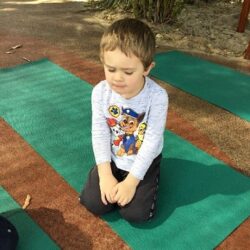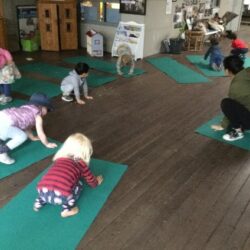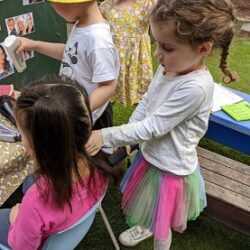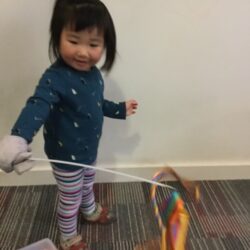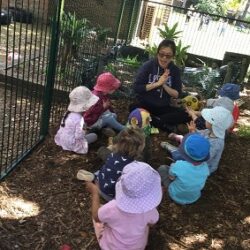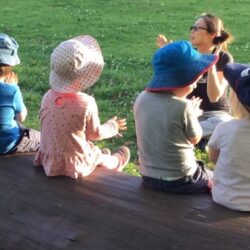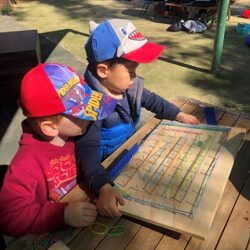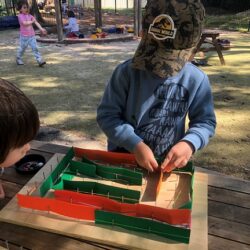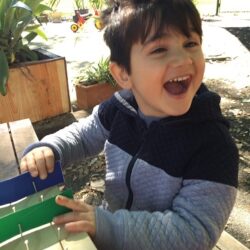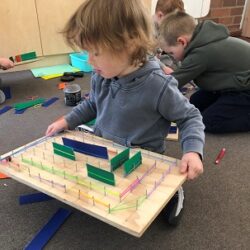Gorton House
The children in the Gorton House’s toddler room can often be found climbing, running, jumping, bicycle-riding, pushing/pulling cars and trucks and walking along the obstacle course frame using large body movements. In this room, educators intentionally plan to respond to the children’s strengths and interest in participating in energetic physical activities, which yoga ideally complements.
Yoga sessions have been implemented in the room almost every day since late August. The children have really taken to the routines and disciplines involved and as such, their interest levels as a collective, as well as as individuals, have increased.
As the children learn new poses and movements, their minds as well as their bodies are exercised. They have even begun to predict the poses and sequences involved. Some of the yoga poses take practice, and the children have had to learn new ways of moving; as such, actually accomplishing these new poses enhances their self-confidence and resilience. The poses they have been doing are: flower, dog, mountain, boat, tree and many more. These movements all engage complex sensory-motor skills and movement patterns.
Yoga provides a healthy climate for children in group care, and provides them with an opportunity to connect with themselves and to find some inner ‘down time’. During or after a busy day in the toddlers’ room, yoga can be a good technique to bring everyone back together, calm down and restore themselves for the rest of the day.
Johnson House
Johnson House has been busy this week with many emerging stylists working hard in the new hairdresser salon set up. Lots of discussions and experiments by the children with hair were recently observed by the educators, which prompted the creation of a dedicated hair salon space. Images of a range of hairstyles were added, together with props to help this interest flourish. It was a great opportunity to talk with children about similarities and differences, to break down gender stereotypes and to provide a space where the children were empowered to make decisions, share ideas and use real life experiences of visiting the hairdressers to further extend their play. As the days have progressed, more provisions have been added based on ideas from the children, including a space to pay, books in which to write appointment times and, of course, the addition of sparkly shampoo! Some children have even refined their skills in plaiting and have been able practice these skills, helping them to feel successful and motivated to help and teach their peers. Such experiences help the children to transfer their knowledge of an experience and to translate this into play ideas and pretend scenarios. It also helps the children to develop confidence and to work with peers to help facilitate positive peer interactions.
Murray House
Infants
The children in Murray House infants love getting involved in music and movement, and their educators have been working together to incorporate and introduce new songs and material to create fun learning experiences for the children.
Recently Occupational Therapist Lisa designed a music and movement session for the children to support their fundamental physical skills. Lisa selected 10 songs with lots of visual signs to help the children to understand the sequence of the session and to become more familiar with this structured group time. She also added lots of interesting musical instruments like shakers, as well as ribbons to, encourage lots of movement and to help the children also develop their fine motor skills.
As Lisa repeats and revisits this group session with the children each week, the educators have been noticing that the children are beginning to remember the words and actions of the songs. Early childhood learning research indicates that repetition and revisiting play experiences can benefit young children’s learning and help them to master skills.
Toddlers
Sharing books
The children in Murray House toddlers are continuing to enjoy participating in educators Denise’s and Thi My’s language groups. Thi My has been promoting a love of books with the children by responding to their regular requests for their favorite books, which are currently those written by author Julia Donaldson. Denise has been extending children’s emotional literacy and self-regulation through reading a series of books related to kindness and positive emotions. Each storybook illustrates actions that are linked to a particular emotion, for example, giving a cuddle to someone who is feeling sad is being kind to them, or facing something that may be challenging exhibits bravery. The children were enthusiastic to learn more about the concepts of being grateful, brave and mindful, and were able to start giving opinions about the occasions they have expressed these emotions outside their care environment.
Mindful eating
Extending on Occupational Therapist Lisa’s integrated group on mindful eating, educator Thi My brought in some home-grown oranges and rosemary for the children to explore and taste. They were encouraged to use their senses to explore these foods. The children felt them, squeezed them, smelled them, observed them, and tasted them. They also used their language skills to describe their experience. For instance, most of them described the oranges as juicy, sweet, soft, and smooth. They commented that the rosemary was “spiky”, “too smelly”, and “too spicy”. Educators also took the opportunity to revisit the importance of handwashing before eating, as well as discussing ‘sometimes’ foods and ‘everyday’ foods. A book called Eat Your Greens Goldilocks, by Steve Smallman, was also shared with the children after the sensory food experience. This aimed to reinforce for the children the importance of eating nutritious food, and to help them to develop an awareness of sometimes foods and everyday foods. The children showed understanding that jelly and ice-cream are definitely sometimes foods!
Excursions
The children are also continuing to enjoy excursions to the lawn area, and they regularly request that educator Mandy to go with them.
Mandy has been fostering children’s learning by incorporating activities into these excursions to support children’s development across many domains. For instance, before each excursion, she encourages the children to sit down to discuss the rules and expectations for the excursion, thus fostering children’s group participation, language and regulation skills, as well as their ability to follow verbal instructions. The development of children’s physical and coordination skills are fostered through various ball games and running games during the excursions, and their social and emotional skills are fostered through games where they are encouraged to take turns, to think about fairness, and see to others’ perspectives.
Robinson House
The children in Robinson House often engage in construction play, be it with wooden blocks, Duplo, Lego, magnetic tiles, recycled boxes or plastic cups. Their creative constructions sometimes become a prop or a scenario for their pretend play, and sometimes the children hypothesise and experiment by making ramps and crashing their constructions into each other.
To further support their interest in construction and their developing dispositions of curiosity, as well as skills such as hypothesising and experimenting, the children and educator Anne began a marble maze project. They first created marble mazes using Duplo on Duplo boards to create a path or paths for marbles to roll on. This was activity was then also done with Lego, which offered a different experience as the children had to problem solve ways to fit their marbles with smaller bricks, and the smaller Lego boards.
After experimenting with Duplo and Lego to make marble mazes, Anne reused some Geoboards from an experience last year to create marble mazes with the children. Geoboards are wooden boards with nails hammered halfway into them to make a grid. The children had strips of corrugated cardboard in different lengths and rubber bands to help them create walls for their mazes on the Geoboards. This was tricky and finicky, as they had to stretch the rubber bands across rows of nails, and find out ways to create walls. The children were sometimes challenged by how they could secure the cardboard to the nails, or stopping their marbles from getting stuck. However, with some encouragement, suggestions and modelling from Anne, and with the children problem solving to find solutions, they persisted and eventually created routes for their marbles to roll, whether by following Anne’s methods, or by devising their own methods. It was amazing to see how one child layered several rubber bands over the same row of nails to create a wall, and then another child use the rubber bands to launch their marbles! Very innovative, which is always inspiring and encouraging to watch!
Through this experience the children demonstrated their commitment to the task, and their persistence to solve difficulties. They were all excited to try out their new marble mazes. With big smiles on their faces they exclaimed things such as “I did it!” or “Look Anne!”, often celebrating when they seemed to have achieve their goals, whether this was for their marbles to go through without getting stuck, or for their marbles to stay safely on the Geoboard without falling! It was also great to see the children collaborate and negotiate their ideas when creating routes on larger Geoboards. With the variety of capacities and knowledge that each child brings from previous STEAM (Science, Technology, Engineering, Art and Mathematics) related experiences in the program, they can offer and share ideas to learn from each other.
